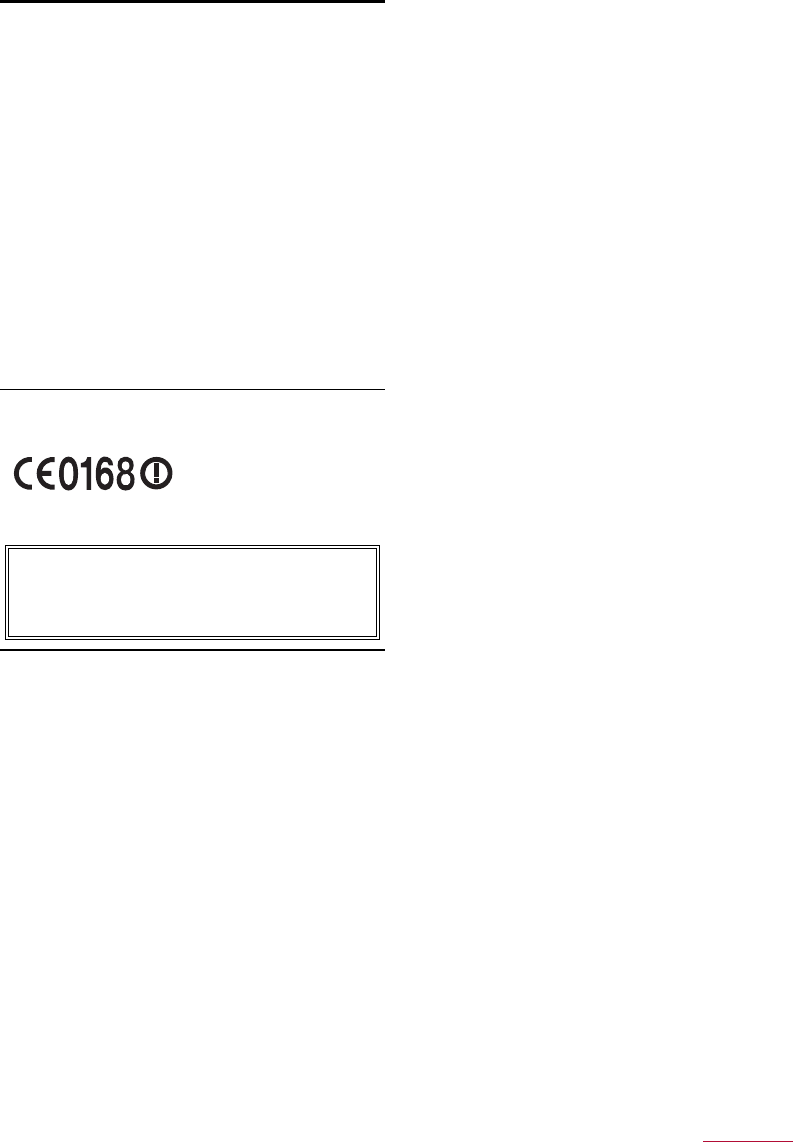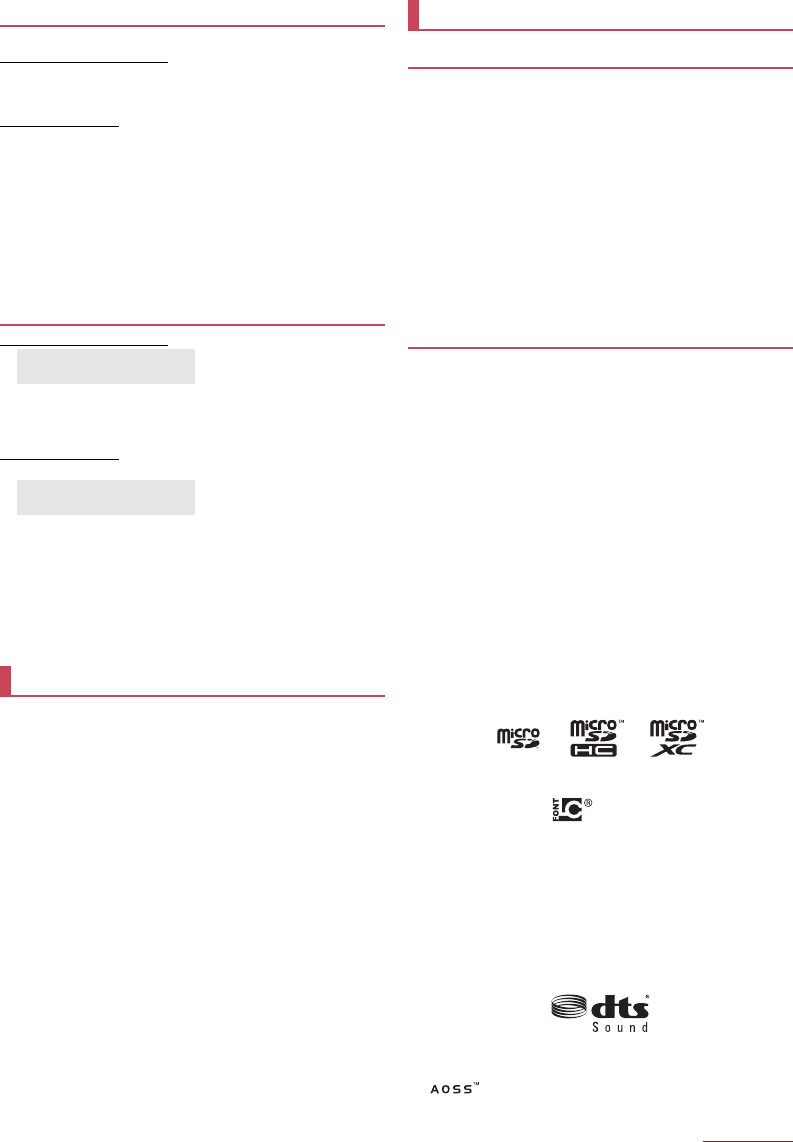operational manual

90 付録/索引
SH-02F_J_12.fm
[90/94]
European RF Exposure Information
Your mobile device is a radio transmitter and receiver. It is
designed not to exceed the limits for exposure to radio waves
recommended by international guidelines. These guidelines were
developed by the independent scientific organization ICNIRP and
include safety margins designed to assure the protection of all
persons, regardless of age and health.
The guidelines use a unit of measurement known as the Specific
Absorption Rate, or SAR. The SAR limit for mobile devices is 2 W/kg
and the highest SAR value for this device when tested at the ear is
0.567 W/kg
※
and when worn on the body is 0.451 W/kg
※
.
For body-worn operation, this mobile device has been tested and
meets the RF exposure guidelines when used with an accessory
containing no metal and positioning the handset a minimum of 1.5
cm from the body. Use of other accessories may not ensure
compliance with RF exposure guidelines.
As SAR is measured utilizing the devices highest transmitting
power the actual SAR of this device while operating is typically
below that indicated above. This is due to automatic changes to
the power level of the device to ensure it only uses the minimum
level required to reach the network.
※The tests are carried out in accordance with international
guidelines for testing.
Declaration of Conformity
In some countries/regions including Europe, there are restrictions on the
use of 5GHz WLAN that may limit the use to indoors only.
If you intend to use 5GHz WLAN on the device, check the local laws and
regulations beforehand.
FCC Notice
This device complies with part 15 of the FCC Rules.
Operation is subject to the following two conditions:
(1) This device may not cause harmful interference, and (2) this
device must accept any interference received, including
interference that may cause undesired operation.
Changes or modifications not expressly approved by the
manufacturer responsible for compliance could void the user's
authority to operate the equipment.
Information to User
This equipment has been tested and found to comply with the
limits of a Class B digital device, pursuant to Part 15 of the FCC
Rules. These limits are designed to provide reasonable protection
against harmful interference in a residential installation. This
equipment generates, uses and can radiate radio frequency
energy and, if not installed and used in accordance with the
instructions, may cause harmful interference to radio
communications.
However, there is no guarantee that interference will not occur in
a particular installation; if this equipment does cause harmful
interference to radio or television reception, which can be
determined by turning the equipment off and on, the user is
encouraged to try to correct the interference by one or more of
the following measures:
1. Reorient/relocate the receiving antenna.
2. Increase the separation between the equipment and receiver.
3. Connect the equipment into an outlet on a circuit different
from that to which the receiver is connected.
4. Consult the dealer or an experienced radio/TV technician for
help.
5 GHz WLAN Operation in USA
Within the 5.15-5.25 GHz band, UNII devices are restricted to
indoor operations to reduce any potential for harmful
interference to co-channel Mobile Satellite Services (MSS)
operations.
FCC RF Exposure Information
Your handset is a radio transmitter and receiver.
It is designed and manufactured not to exceed the emission limits
for exposure to radio frequency (RF) energy set by the Federal
Communications Commission of the U.S. Government.
The guidelines are based on standards that were developed by
independent scientific organizations through periodic and
thorough evaluation of scientific studies. The standards include a
substantial safety margin designed to assure the safety of all
persons, regardless of age and health.
The exposure standard for wireless handsets employs a unit of
measurement known as the Specific Absorption Rate, or SAR.
The SAR limit set by the FCC is 1.6 W/kg.
The tests are performed in positions and locations (e.g., at the ear
and worn on the body) as required by the FCC for each model.
The highest SAR value for this model handset when tested for
use at the ear is 0.54 W/kg and when worn on the body, as
described in this user guide, is 0.81 W/kg.
For body worn operation, this phone has been tested and meets
the FCC RF exposure guidelines. Please use an accessory
designated for this product or an accessory which contains no
metal and which positions the handset a minimum of 1.5 cm from
the body.
The use of accessories that do not satisfy these requirements
may not comply with FCC RF exposure requirements, and should
be avoided.
The FCC has granted an Equipment Authorization for this model
handset with all reported SAR levels evaluated as in compliance
with the FCC RF emission guidelines. SAR information on this
model handset is on file with the FCC and can be found under the
Display Grant section of (http://transition.fcc.gov/oet/ea/fccid/)
after searching on FCC ID APYHRO00202.
Additional information on Specific Absorption Rates (SAR) can
be found on the FCC website at (http://www.fcc.gov/
encyclopedia/radio-frequency-safety) .
FCC ID Location
The FCC ID for this device can be found under the back cover.
Please remove the back cover when you want to see the FCC ID.
Hereby, Sharp Telecommunications of Europe Ltd, declares that this
SH-02F is in compliance with the essential requirements and other
relevant provisions of Directive 1999/5/EC.
A copy of the original declaration of conformity can be found at the
following Internet address:
(http://www.sharp.co.jp/k-tai/)
SH-02F_J.book 90 ページ 2013年12月5日 木曜日 午前7時47分

91 付録/索引
SH-02F_J_12.fm
[91/94]
This model SH-02F mobile phone complies with Japanese technical
regulations and international guidelines regarding exposure to
radio waves.
This mobile phone was designed in observance of Japanese technical
regulations regarding exposure to radio waves (*1) and limits to exposure
to radio waves recommended by a set of equivalent international
guidelines. This set of international guidelines was set out by the
International Commission on Non-Ionizing Radiation Protection
(ICNIRP), which is in collaboration with the World Health Organization
(WHO), and the permissible limits include a substantial safety margin
designed to assure the safety of all persons, regardless of age and
health condition.
The technical regulations and international guidelines set out limits for
radio waves as the Specific Absorption Rate, or SAR, which is the value
of absorbed energy in any 10 grams of tissue over a 6-minute period.
The SAR limit for mobile phones is 2.0 W/kg. The highest SAR value for
this mobile phone when tested for use at the ear is 0.637 W/kg. There
may be slight differences between the SAR levels for each product, but
they all satisfy the limit.
The actual SAR of this mobile phone while operating can be well below
that indicated above. This is due to automatic changes to the power level
of the device to ensure it only uses the minimum required to reach the
network. Therefore in general, the closer you are to a base station, the
lower the power output of the device.
This mobile phone can be used in positions other than against your ear.
This mobile phone satisfies the international guidelines when used with a
carrying case or a wearable accessory approved by NTT DOCOMO,
INC. (*2). In case you are not using the approved accessory, please use
a product that does not contain any metals, and one that positions the
mobile phone at least 1.5 cm away from your body.
The World Health Organization has stated that “a large number of
studies have been performed over the last two decades to assess
whether mobile phones pose a potential health risk. To date, no adverse
health effects have been established as being caused by mobile phone
use.”
Please refer to the WHO website if you would like more detailed
information.
(http://www.who.int/docstore/peh-emf/publications/facts_press/
fact_english.htm)
Please refer to the websites listed below if you would like more detailed
information regarding SAR.
Ministry of Internal Affairs and Communications Website:
(http://www.tele.soumu.go.jp/e/sys/ele/index.htm)
Association of Radio Industries and Businesses Website:
(http://www.arib-emf.org/index02.html) (in Japanese only)
NTT DOCOMO, INC. Website:
(http://www.nttdocomo.co.jp/english/product/sar/)
SHARP Corporation Website:
(http://www.sharp.co.jp/products/menu/phone/cellular/sar/index.html) (in
Japanese only)
*1 Technical regulations are defined by the Ministerial Ordinance
Related to Radio Law (Article 14-2 of Radio Equipment Regulations).
*2 Regarding the method of measuring SAR when using mobile phones
in positions other than against the ear, international standards
(IEC62209-2) were set in March of 2010. On the other hand,
technical regulation is currently being deliberated on by national
council (As of October, 2011).
Use only optional parts specified by NTT DOCOMO for use with the
handset.
May cause fires, burns, bodily injury or electric shock.
Do not throw the handset into a fire.
The internal battery may catch fire, explode, overheat or leak.
Do not dispose of the handset in ordinary garbage.
May cause fires or damage to the environment. Take the unnecessary
handset to a sales outlet such as a docomo Shop or follow the
instructions by a local institution that handles used handsets.
Earphone Signal Level
The maximum output voltage for the music player function, measured in
accordance with EN 50332-2, is 117.0 mV.
Avoid using the handset in extremely high or low temperatures.
Use the handset within the range of a temperature between 5°C and
35°C and a humidity between 45% and 85%.
Charge battery in areas where ambient temperature is between 5°C
and 35°C.
Do not point the illuminated light directly at someone’s eyes.
Especially when you shoot still pictures or videos of young
children, keep 1 m or more distance from them.
Do not use Mobile light near people’s faces. Eyesight may be temporarily
affected leading to accidents.
■Bluetooth function
The Bluetooth word mark and logos are owned by the Bluetooth SIG,
INC. and any use of such marks by NTT DOCOMO, INC. is under
license. Other trademarks and trade names are those of their
respective owners.
(Business hours: 9:00 a.m. to 8:00 p.m.)
s0120-005-250 (toll free)
※Service available in: English, Portuguese, Chinese, Spanish.
※Unavailable from part of IP phones.
(Business hours: 9:00 a.m. to 8:00 p.m. (open all year round))
From DOCOMO mobile phones
(In Japanese only)
r(No prefix) 151 (toll free)
※Unavailable from land-line phones, etc.
From land-line phones
(In Japanese only)
s0120-800-000 (toll free)
※Unavailable from part of IP phones.
Please confirm the phone number before you dial.
Specific Absorption Rate (SAR) of Mobile
Phones CAUTION
To prevent possible hearing damage, do not listen at high
volume levels for long periods.
Inquiries
General inquiries
<docomo Information Center>
SH-02F_J.book 91 ページ 2013年12月5日 木曜日 午前7時47分

92 付録/索引
SH-02F_J_12.fm
[92/94]
(Business hours: 24 hours (open all year round))
From DOCOMO mobile phones
(In Japanese only)
r(No prefix) 113 (toll free)
※Unavailable from land-line phones, etc.
From land-line phones
(In Japanese only)
s0120-800-000 (toll free)
※Unavailable from part of IP phones.
Please confirm the phone number before you dial.
For Applications or Repairs and After-Sales Service, please contact
the above-mentioned information center or the docomo Shop etc. near
you on the NTT DOCOMO website.
NTT DOCOMO website:
(http://www.nttdocomo.co.jp/english/)
From DOCOMO mobile phones
* You are charged a call fee to Japan when calling from a land-line
phone, etc.
※If you use SH-02F, you should dial the number +81-3-6832-6600
(to enter “+”, touch and hold “0”).
From land-line phones
<Universal number>
* You might be charged a domestic call fee according to the call rate
for the country you stay.
※For international call access codes for major countries and universal
number international prefix, refer to DOCOMO International Services
website.
If you lose your handset or have it stolen, immediately take the steps
necessary for suspending the use of the handset.
If the handset you purchased is damaged, bring your handset to a
repair counter specified by DOCOMO after returning to Japan.
本製品及び付属品は、日本輸出管理規制(「外国為替及び外国貿易
法」及びその関連法令)の適用を受ける場合があります。また米国再
輸出規制(Export Administration Regulations)の適用を受けます。
本製品及び付属品を輸出及び再輸出する場合は、お客様の責任及び
費用負担において必要となる手続きをお取りください。詳しい手続
きについては経済産業省または米国商務省へお問い合わせくださ
い。
お客様が本製品を利用して撮影またはインターネット上のホー
ムページからのダウンロードやテレビ、ビデオなどにより取得し
た文章、画像、音楽、ソフトウェアなど第三者が著作権を有するコ
ンテンツは、私的使用目的の複製や引用など著作権法上認められ
た場合を除き、著作権者に無断で複製、改変、公衆送信などするこ
とはできません。
実演や興行、展示物などには、私的使用目的であっても撮影また
は録音を制限している場合がありますので、ご注意ください。
また、お客様が本製品を利用して本人の同意なしに他人の肖像を
撮影したり、撮影した他人の肖像を本人の同意なしにインター
ネット上のホームページに掲載するなどして不特定多数に公開
することは、肖像権を侵害する恐れがありますのでお控えくださ
い。
「FOMA」、「dメニュー」、「dマーケット」、「おサイフケータイ」、「ト
ルカ」、「mopera U」、「ビジネスmopera」、「デコメール®」、「デコメ
絵文字®」、「iアプリ」、「iモード」、「iチャネル」、「iD」、
「WORLD WING」、「公共モード」、「WORLD CALL」、「おまかせ
ロック」、「ケータイデータお預かりサービス」、「かざしてリン
ク」、「エリアメール」、「マチキャラ」、「iコンシェル」、「spモー
ド」、「Xi」、「Xi/クロッシィ」、「声の宅配便」、「あんしんスキャ
ン」、「eトリセツ」、「iD」ロゴ、「Xi」ロゴは(株)NTTドコモの商標ま
たは登録商標です。
キャッチホンは日本電信電話株式会社の登録商標です。
Microsoft®、Windows®、Windows Media®、Windows Vista®、
Exchange®は、米国Microsoft Corporationの米国およびその他
の国における商標または登録商標です。
OracleとJavaは、Oracle Corporation及びその子会社、関連会社の
米国及びその他の国における登録商標です。
文中の社名、商品名等は各社の商標または登録商標である場合が
あります。
QRコードは株式会社デンソーウェーブの登録商標です。
microSDロゴ、microSDHCロゴ、microSDXCロゴはSD-3C, LLCの
商標です。
この製品では、シャープ株式会社が液晶画面で見やすく、読みや
すくなるよう設計したLCフォントが搭載されています。LCフォ
ント/LCFONTおよび は、シャープ株式会社の登録商標
です。
OBEX™は、Infrared Data Association®の商標です。
aはフェリカネットワークス株式会社の登録商標です。
For DTS patents, see (http://patents.dts.com) . Manufactured
under license from DTS Licensing Limited. DTS, the Symbol, &
DTS and the Symbol together are registered trademarks, and
DTS Sound is a trademark of DTS, Inc. © DTS, Inc. All Rights
Reserved.
PhotoScouter®は株式会社モルフォの登録商標です。
及び、AOSS™は株式会社バッファローの商標です。
Repairs
For loss, theft, malfunction, and inquiries
while overseas (24-hour reception)
International call access code
for the country you stay
-81-3-6832-6600*
(toll free)
Universal number international
prefix
-8000120-0151*
輸出管理規制
知的財産権について
著作権・肖像権について
商標について
SH-02F_J.book 92 ページ 2013年12月5日 木曜日 午前7時47分